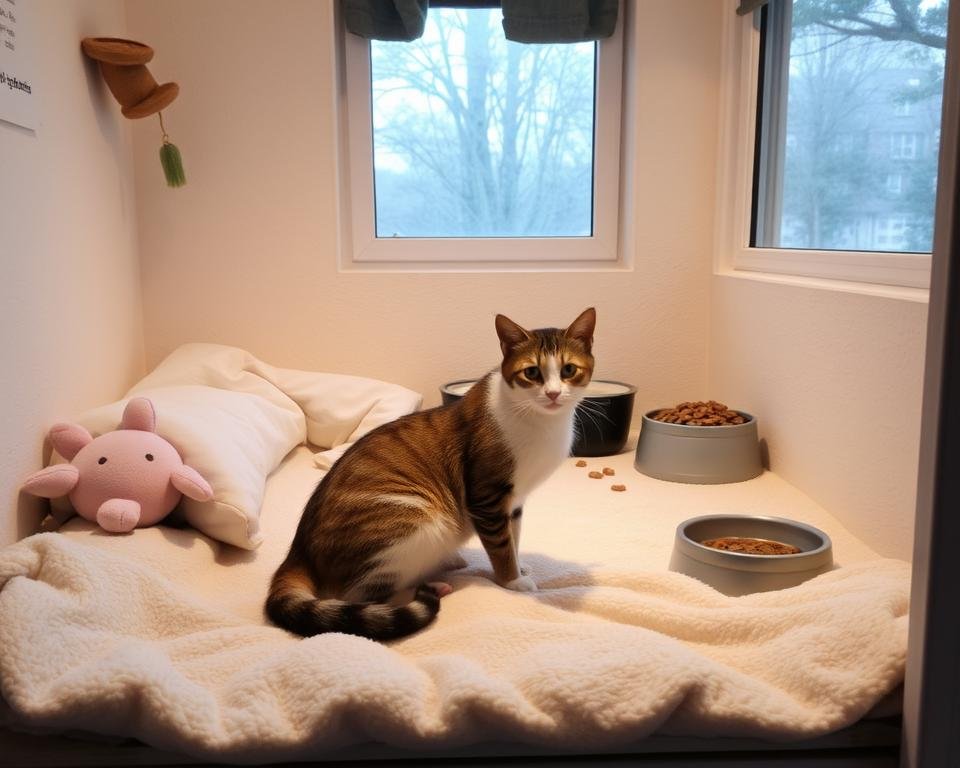Bringing a stray cat into your home can be very rewarding. But, it’s important to prepare carefully. Quarantining the cat for two weeks is a key step. This lets you check the cat’s health, keeping everyone safe.
Stray cats might have picked up diseases or parasites on the streets. A detailed medical check is needed to find and treat any health issues. Vets will do exams, lab tests, and fecal samples to look for problems like feline leukemia or parasites.
The quarantine time helps the cat get used to indoor life. Moving from the streets to a home is a big change. The two weeks let the cat adjust, get a routine, and trust its new family.
Following quarantine rules keeps your new cat and other pets healthy. This careful step stops diseases from spreading. It also makes it easier for the stray cat to settle into its new home.
Understanding Stray Cats and Their Behavior
It’s key to know the difference between stray and feral cats. Stray cats were once pets but got lost or abandoned. They might look a bit rough but are friendly and want to be with people. Feral cats, on the other hand, are born in the wild and don’t like people much.
Signs of a Stray Cat
Spotting a stray cat is easy. They show these signs:
- They are friendly and want to play or cuddle
- They look sick or hurt
- They don’t have tags or microchips
Initial Assessment of a Stray’s Condition
When you see a stray cat, watch how it acts and check its health. Look for any signs of sickness or injury. Also, check for tags or microchips that might show who it belongs to. Stray cats might adjust better to living indoors than feral cats, making them easier to adopt.

“Understanding the socialization continuum helps advocates, shelter staff, caregivers, and veterinary professionals care for cats effectively.” – Alley Cat Allies
How Long Should a Stray Cat Be Quarantined
When caring for a stray cat, knowing how long to quarantine is key. The usual cat quarantine duration is about two weeks. This time lets for a full medical check, including tests for diseases and parasites. It also helps the cat get used to indoor life and watch for any health or behavior problems.
Some say stray cats should stay isolated for three months. But, if a vet says the cat is healthy, a shorter quarantine might be okay. The exact time depends on the cat’s health and how it acts, making sure everyone stays safe.
Good stray cat care means creating a safe, loving space while watching for health risks. Following the cat quarantine duration helps the stray cat adjust well to its new home.

Deciding on the cat quarantine duration should involve a vet. They can tailor advice based on the stray cat’s needs. This way, cat owners can ensure the stray cat’s happiness and success in its new home.
Medical Considerations Before Integration
When you rescue a stray cat, its health is top priority. Feline health screenings are key to keep the cat and other pets safe.
Essential Health Screenings
First, test for common cat diseases like FIV and FeLV. Also, check for internal parasites with a fecal exam. A vet should do a physical check for injuries or infections.
Common Health Issues in Stray Cats
Stray cats face many health problems. These include upper respiratory infections, parasites, ear mites, and dental issues. They need veterinary care for strays to get better before moving in.
Vaccination and Treatment Protocols
Stray cats need core pet vaccinations like rabies and FVRCP. They also get the FeLV vaccine. Deworming and flea treatments are vital to fight parasites. A vet will create a treatment plan based on the cat’s health and age.

“Proper medical care and a quarantine period are key when introducing a stray cat to a new home. They ensure the safety and well-being of both the cat and any existing pets.”
Introducing Your Stray Cat to a New Home
Bringing a stray cat home needs patience and careful planning. It’s important to make the introduction slow and stress-free. This lets the cat get used to the new home and acclimate to its new feline socialization smoothly.
First, create a quiet, special area for the cat. This safe room should have a litter box, food, water, toys, and a comfy bed. Let the cat get to know this space well before showing it other parts of the house.
- Start a scent swapping process. Exchange items between the cat’s area and the rest of the house. This helps the other pets get used to the new cat’s smell.
- Let the stray cat explore the main living areas when the other pets are away. This lets it claim its territory.
- Set up side-by-side meetings. Keep the cats apart but let them see each other. This helps them get used to each other’s presence.
Use positive actions and play to make the cat feel safe and happy. Remember, cats take time to adjust, from days to weeks. It depends on their personalities.
“Cats mostly talk through body language. They show feelings like anger, play, and fear through their posture, face, and tail.”
Watch for signs of stress or fights. If you see any, use loud noises or a spray bottle with water to keep everyone safe. With time and effort, your stray cat will become a cherished family member.

Conclusion
Adopting a stray cat can be very rewarding. It saves a life and gives a loving home to an animal in need. The process takes time, patience, and commitment, but the bond with a rescued cat is strong.
Proper quarantine, medical care, and a slow introduction to a new home are key. These steps help ensure a successful adoption. By following these guidelines, you can help a stray cat live a happy, healthy life indoors.
Stray cat adoption benefits the animal and promotes responsible pet ownership. It also improves feline welfare. The positive impact goes beyond the individual animal, benefiting the community as a whole.
Opening your home to a stray cat shows your compassion and commitment to animal welfare. You can give a loving, stable home to a once-displaced feline. This creates a lasting bond that enriches both your life and theirs.
FAQ
Q: How long should a stray cat be quarantined?
A: It’s best to keep a stray cat in quarantine for two weeks. This ensures they are healthy and don’t have contagious diseases. During this time, they can be checked for FIV and FeLV, and treated for parasites and other health issues.
Q: What are the differences between stray and feral cats?
A: Stray cats are often lost or abandoned pets. They may look dirty but are usually friendly and want human contact. Feral cats, on the other hand, are born in the wild and don’t get along with people.
Q: How can I identify a stray cat?
A: Look for signs of friendliness, injuries, or poor health in a stray cat. First, observe how the cat acts. Check for ID tags or microchips. Also, look for signs of illness or injury.
Q: What health screenings are essential for a stray cat?
A: Key health checks include tests for FIV and FeLV, and fecal exams for parasites. A physical exam is also important to find injuries or infections. Common problems in stray cats include respiratory infections, parasites, ear mites, and dental issues.
Q: How should I introduce a stray cat to my home?
A: Introducing a stray cat to your home needs patience and planning. Start with a small, quiet space for the cat to get used to. Then, slowly introduce it to more areas and pets. Use positive reinforcement and play to help the cat trust you.



